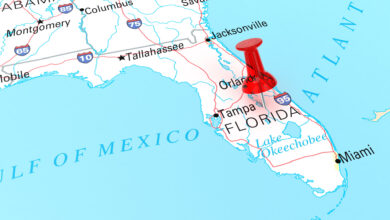We’re No. 1! Can we afford it?
One day last month, a truck slammed into an overpass on Interstate 75 south of Ocala, causing the interstate to be shut down for hours. Traffic was diverted off the road that carries more than 70,000 cars a day.
All roads running north and south through Ocala were jammed. Really jammed. County Road 475, which I live on, was backed up 2 or 3 miles. U.S. 441 moved at a crawl. Gridlock reigned.
Welcome to America’s fastest growing state. Our governor, Ron DeSantis, has been traveling the country boasting that Florida is the No. 1 state. His evidence? Some 1,000 people move to the Sunshine State every day. That’s enough people to create a city the size of Tampa every year.
Heck, here in Ocala, an estimated 94 new people move in every week, or about six new households every day. Today, almost 400,000 people live in Ocala/Marion County.
Hooray, right?
Based on all available evidence, the people are going to keep coming in droves. Already, Florida’s population has grown from 8 million in 1973 to 23 million today. Over the course of that 50 years, Ocala/Marion County has grown from 83,000 residents to five times that. And by 2040, expect at least another 100,000 to make Ocala home.
So, while DeSantis and the Chamber & Economic Partnership do backflips in celebration of the influx of new residents and the development dollars they spur, there are some realities that must be faced.
Take roads. They’re crowded and getting more so. Over the next 20 or so years, Ocala/Marion County plans to do $4 billion of road construction. Great. Except, that’s almost a billion dollars less than they need.
Take schools. Currently, there are 5,400 teacher vacancies across the state and the number just keeps growing. Here in Ocala, too many schools are overcrowded, and the School Board isn’t sure where it will get the money to build new ones.
Take water. Oh, where to start? Nutrient pollution is fouling our springs, which means it’s fouling our groundwater, that is, our drinking water. It’s also causing red tide up and down Florida’s West Coast, leaving thousands of tons of dead fish on our iconic beaches. And, with 1,000 people moving in every day, Florida is one bad drought away from a water shortage. Not to worry, you say? It is projected that Florida’s thirst for water in 2030 will be almost 30 percent greater than it was in 2005.
Finally, affordable housing. The median price for a home in Florida is now $407,000 ($274,000 here in Ocala). Meanwhile, median rent costs escalated 30 percent from 2020 to 2022, jumping from $1,340 to $1,760. A Florida Policy Institute study of housing costs concluded that “Florida has become one of the least affordable places to live in the nation.”
So, yes, we’re No. 1 – in growth. But while the people and dollars are flowing to big businesses and the governor’s delight, we have monumental challenges already – and there’s another 7 million people expected to move in by 2050.
Sure, these are all problems that can be solved. But will we Floridians be willing to pay the hefty price to seriously address them?
Historically, one of Florida’s great lures, in addition to fabulous weather, spectacular scenery and an abundance of recreational options, has been its low cost of living. Today, that affordability is in question.
I remember when I first came to Ocala in 1995. A local panel of leaders had just completed the Vision 2020 study so we could prepare for the 150,000 new residents that would be moving in over the next 25 years. Not sure they anticipated the kind of growth we’re seeing today.
Studies and plans are good and necessary if they are implemented. If they can be implemented. With the unrelenting influx of new people, it seems impossible for Florida and Ocala to keep up. And that, folks, affects every one of us every day.
Hip, hip, hooray. We’re No. 1. The question is, can we afford it economically and environmentally, and for how long?
Over the next 20 or so years, Ocala/Marion County plans to do $4 billion of road construction.







